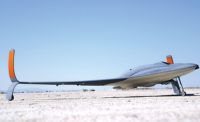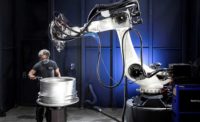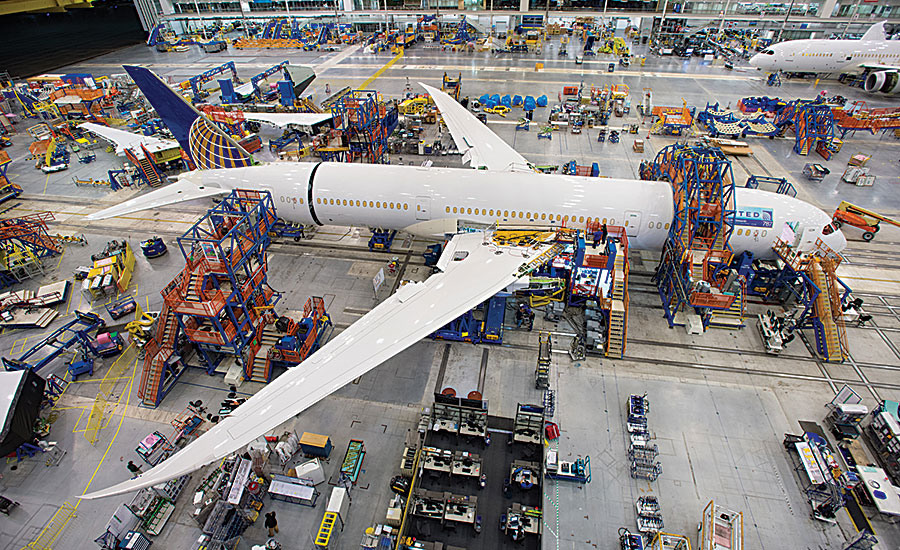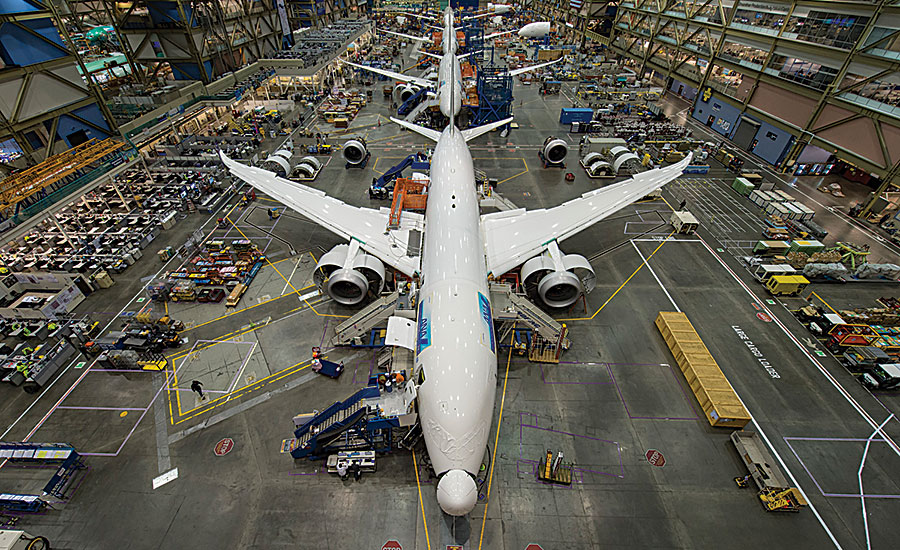Assembly Automation Takes Off in Aerospace Industry

By investing in automation, Boeing hopes to improve productivity and reduce its huge backlog. Photo courtesy Boeing Commercial Airplanes

Boeing plans to use robots to assemble fuselage sections of its next-generation 777X jetliner. Photo courtesy Boeing Commercial Airplanes

Airbus is deploying two-axis humanoid robots on its assembly lines. Photo courtesy Airbus

Pratt & Whitney is investing $1 billion to prepare its factories for jet engine production increases. Photo courtesy Pratt & Whitney

Robots can improve cost, quality and production rates, while addressing safety and ergonomic issues. Photo courtesy Durr AG

This drilling robot crawls up the side of aircraft fuselages. Photo courtesy Boeing Commercial Airplanes

This snake-like robot can tighten fasteners inside wing structures and other confined spaces. Illustration courtesy Fraunhofer Institute for Machine Tools and Forming Technology

Engineers at the Boeing Advanced Research Center are developing remotely operated vehicles that can crawl inside small spaces in airplanes. Photo courtesy University of Washington

Traditionally, automation in aerospace manufacturing has consisted of large monument machines that are fed from manual processes. Photo courtesy Boeing Commercial Airplanes

Aerospace engineers are looking for new way to automate aircraft fuselage and wing assembly. Photo courtesy GKN Aerospace

This mobile robotic drill is designed for aerospace applications. Photo courtesy Comau LLC

This overhead horizontal assembly line will produce the PurePower PW1100G-JM jet engine for the Airbus 320neo. Photo courtesy Pratt & Whitney












Aerospace manufacturers are bursting at the seams with a backlog of orders. To address that dilemma, they need to automate their factories. The industry is investing heavily in flexible systems that reduce cost, improve quality and boost productivity.
Manufacturers involved in the commercial airliner sector are leading the charge by adopting robots, automated guided vehicles and other technology to solve capacity constraints.
Aerospace production volumes have been increasing steadily over the last three years. For instance, Boeing Commercial Airplanes built 723 airliners in 2014 vs. 648 in 2013 and 601 in 2012. This year, the company is on track to produce 900 aircraft.
Boeing is in an enviable position. It’s currently sitting atop a huge backlog for airliners such as the 737MAX, 777X and 787 Dreamliner. In fact, the aerospace giant currently has more than 5,700 aircraft on order, valued at more than $450 billion.
Within the next three years, Boeing has ambitious plans to increase production of its popular narrow-body, single-aisle 737 jet from 42 aircraft a month to 52. And, the company hopes to slowly ramp up production volume on the more technically complex 787 to 12 planes per month by 2016 and 14 per month by 2020.
Boeing’s archrival, Airbus, also plans to boost output of its most popular airplane, the A320. By 2018, the European company expects to raise production rates from 42 planes a month to 50 units. Its new $600 million assembly line in Mobile, AL, which is scheduled to open later this year, will play a major role in meeting that goal.
Airbus eventually plans to crank up A320 production to 60 planes a month at its factories in China, France, Germany and the United States. That kind of production volume would be unprecedented in the commercial aerospace industry.
Assembly lines at major suppliers, such as GE Aviation, Honeywell, Rockwell Collins, Spirit AeroSystems and UTC Aerospace Systems, are also humming with increased activity. As a result, aerospace engineers are searching for new ways to improve throughput while maintaining strict quality standards. Investing in automation is now considered a necessity, rather than an option.
Pratt & Whitney is investing $1 billion worldwide to prepare its factories for jet engine production increases. It recently benchmarked several automotive manufacturers and revamped its 58-year-old Middletown, CT, plant. The facility now features an overhead horizontal moving assembly line that will produce the PurePower PW1100G-JM engine for the Airbus A320neo.
“The new assembly system offers revolutionary benefits in increased production volume,” claims Joe Sylvestro, vice president of manufacturing operations at Pratt & Whitney. "[And, it provides] ergonomic benefits for the assembly teams working on the engines. [Assemblers] can adjust the engine up and down to their ideal work height, and can rotate the engine to help with difficult to reach areas. The new line is also safer, because ladders and platforms have been fully eliminated, and there is no perching under the engines, bending, stooping and climbing."
“The horizontal assembly system has both vertical lift and rotation capability," adds Tom Mayes, general manager of engine centers and compression module centers at Pratt & Whitney. "It is also programmable, so [engineers] can automate the line depending on volume and move the carriage systems at the rate of output to adjust for customer demand.”
Boeing’s Big Dream
Boeing plans to invest more than $1 billion in automation over the next few years to boost production at its assembly plants. Most of that money will be allocated to state-of-the-art robots for drilling, fastener insertion, riveting, sealing, coating and painting applications, in addition to material handling, carbon-fiber layup and machining operations, such as deburring and shot peening.
Automation is attractive to Boeing for several reasons. For instance, its main assembly line in Everett, WA, is located in a region with a highly skilled workforce. This provides some protection against technology and production delays, but skilled labor comes at a high cost.
On the other hand, Boeing’s newer factory in North Charleston, SC, is located in a region with no historic aerospace workforce. Some skilled people were relocated to the area to implement and operate automation that does some of the jobs done manually on the Everett line.
Because production rates and staffing are not equivalent, the jury is still out on which production method is superior. The large scale and reduced tolerances for lower weight do not allow manual assembly in all areas.
In this instance, Boeing engineers are opting for automated assembly. According to one observer, this optimization can go so far as to eliminate the ability to produce the parts manually.
An additional issue that influences automation allocation is assembler reliability. Boeing can effectively build the 787 with manual labor, argues the observer, but not on days when people perform poorly or fail to show up for work. There are also repetitive jobs with ergonomic risks that can be addressed through automation.
During his keynote speech at last year’s AeroDef Manufacturing Summit in Long Beach, CA, Gerould Young, director of materials and manufacturing technology at Boeing Research & Technology, outlined how automation will play a key role in the company’s future.
“Automation can improve our cost, quality and production rates,” claims Young, who heads a team of 1,000 engineers who are developing next-generation materials and production processes for a wide variety of current and future Boeing products.
According to Young, Boeing is moving toward agile systems that feature “an integrated family of robots, low-cost intelligent systems and lightweight flexible equipment.” However, he warned that numerous challenges still face his team.
For example, Boeing engineers are exploring new applications for robotic riveting. “Replacing human riveting personnel with dual-robotic systems is challenging,” explains Young. “A tremendous amount of knowledge and data is required to automate riveting.”
Young claims that Boeing is migrating toward automated factories that feature “miniaturization, multiple end effectors, multiple robots, and a computer-intense system with a lot of intelligence built-in.
“Aerospace automation is not easy,” says Young. “We’re learning from the auto industry. At the same time, we’re trying to attack the challenges [that are unique to] aerospace.
“Scale, complexity and structural integration make automation challenging for fabrication processes,” Young points out. “Automation optimization for capital costs, rate and number of units has a learning curve. New skills in simulation, sensors, data, computers, integration and robotics will be required to transform our factories for the future.”
No More Monuments
Traditionally, automation in aerospace manufacturing has consisted of large monument machines that are fed from manual processes. However, in the last five years, the aerospace industry has been pushing to improve production and efficiency.
“To accomplish this, entire factory solutions are needed,” says Rob Zerwick, senior proposal and process engineer at Comau LLC, which works with a wide variety of commercial and military aerospace manufacturers, including the new Airbus factory in Mobile. “[Our] customers see value in products that aid [assemblers].
“[Aerospace manufacturers] are looking for suppliers to improve the accuracy, speed and quality of robotic assembly,” adds Zerwick. “Unlike large monument machines, [they] see the value of solutions that are not permanently fixed to the floor or require facility investments, such as isolated foundations or climate-controlled environments. This is pushing automation to be far more intelligent and able to compensate for the environment it is working in.”
“Aerospace manufacturers are looking for all sorts of automation solutions today,” claims Ben Hempstead, PE, mechanical engineering lead and chief of staff at Electroimpact Inc., which has developed a wide variety of automation and tooling solutions for aerospace manufacturers around the world. “We are seeing demand for everything from skin-stringer riveting to spar fastening and assembly, wingbox assembly and fuselage joining.
“I cannot think of an area of aerospace assembly which is not feeling a push for more automation,” adds Hempstead. “A possible exception is interiors assembly. Interiors are typically unique to each airline and aircraft, so a high level of customized integration and assembly is required. The materials can be delicate and the cosmetic requirements are high. This is an area where skilled-touch labor has the upper hand.”
Both the commercial and military sides of the aerospace industry have been investing heavily in composite materials. However, automating assembly processes for a highly variable material such as composites can be very challenging.
“What drives cost in aerospace manufacturing is drilling and filling,” says George “Nick” Bullen, an aerospace consultant who recently retired from Northrop Grumman as principal engineer and technical fellow. “Mechanical fasteners account for 60 percent of the cost of airframe assembly, 80 percent of lost-time injuries and 80 percent of defects. That’s why manufacturers are looking for new ways to drill and fill holes more efficiently.
“It’s also what’s driving more use of composite materials in new aircraft,” explains Bullen, who helped develop Northrop Grumman’s Integrated Assembly Line in Palmdale, CA (the recipient of ASSEMBLY’s 2013 Assembly Plant of the Year award). “However, the growing use of composites has made it more difficult, because you can end up with problems such as fiber pulling and tearing. There are also numerous problems caused by deburring debris that ends up between the composite skin and the metal substructure.”
According to Bullen, the big automation thrust at the moment is to eliminate destack. “During the drilling and countersinking operation, burrs, debris, damage or separation may occur between two pieces of material,” he points out. “Because of the uncertainty of their existence and because there is not currently a way to tell if they are there when together, the two pieces must be taken apart and examined as part of the aerospace manufacturing process.
“After examination and rework, if necessary, the parts are then restacked together for the fastener installation joining process,” explains Bullen. “If this examination could be done without destack, then fasteners could just be installed after drilling and countersinking.
“Elimination of destack enables automated drill and fill,” says Bullen. “The goal is to drill a hole, countersink it, inspect it and insert a fastener. Aerospace manufacturers are also looking for ways to reduce the use of fasteners by using more adhesive bonding.”
Bullen says aerospace engineers are experimenting with new noncontact measurement and inspection systems that “promise to change the way they automate their production processes.” For instance, one leading manufacturer is using a ring laser system that provides a complete image of holes to enable automated filling. The gauge is mounted and integrated into a mobile robotic drilling, countersinking and fastener installation system.
Electroimpact is researching ways to perform on-the-fly inspection of composite automated fiber placement. “As fiber placement machines increase in speed and laydown rates, the opportunity for a lot of scrap to be generated quickly is increasing,” says Hempstead.
“More reliable machines are part of the answer,” adds Hempstead. “But, to avoid downstream rework of very expensive and time-sensitive materials, being able to identify and rectify issues in real time is a hot topic. This involves machine vision, infrared sensing, fast processing, laser projection, and a sophisticated user interface to identify the problem, present solutions and document the result.”
Hempstead and his colleagues are also focusing on developing “ever faster, more accurate and more reliable riveting machines.” One challenge they’re faced with is integrating automation with traditional manual assembly processes.
“Many large [aerospace] assemblies require manual work in the assembly process to [be done] alongside or concurrent with automation for the highest overall efficacy,” says Hempstead. “The man-machine interface and safety requirements often push the envelope of international and domestic safety standards.”
Electroimpact’s newest product is the E7000 riveting machine. It has been clocked at rates of up to 20 rivets per minute, making it the fastest riveting machine in the world. The device also boasts the most efficient use of factory floor space compared to conventional riveting machine designs.
“This versatile configuration is well-suited for automatic fastening of a wide range of aircraft parts, such as fuselage and wing panels,” claims Hempstead. “The E7000 is designed for maximum reliability and maintainability, with an open end-effector design and a special raised access platform for fast and easy access to the critical drilling and riveting mechanisms inside. Additionally, fully automatic change out of the drills, riveting anvils and fastener injectors reduces the need for constant operator intervention and improves overall machine productivity.”
Assembly Challenges
Many aerospace manufacturers are looking to automakers and suppliers for inspiration. However, there are several key differences between embracing automation in the auto industry vs. commercial aerospace.
Tolerances are much higher in aerospace applications, and the average subassembly is larger and heavier.
Production volumes in aerospace are also much smaller than in the auto industry, but the life expectancy of the products being produced is much higher.
Boeing recently partnered with the Department of Mechanical Engineering at the University of Washington to tackle some of those challenges and develop advanced automation equipment and new production processes.
Several projects underway are focusing on robotic structural aircraft assembly. For example, one team of engineers is developing robots and unmanned vehicles that can help build the inside of airplane wings, while another team of engineers are figuring out how to automate the riveting of fuselages.
“We currently are working on flexible automation, so we have a number of robotic devices and sensors,” says Per Reinhall, director of the Boeing Advanced Research Center. “Confined space automation is one of our key projects. We are looking at developing tools and machines that [assemblers] can operate remotely so they don’t have to physically enter confined spaces.
“Compared to the auto industry, which is highly automated, the scale or size of aircraft, the precision required, and the quantity of parts make aerospace automation a challenge,” Reinhall points out. Other hurdles include tight tolerances, low production volumes and tradition.
“Low production volumes can make it difficult to parcel out automation costs over short time periods,” says Hempstead. “[Investing in capital equipment] makes quarterly reports look bad. However, tight tolerances are an argument in favor of automation vs. manual drill templates or hand layup of carbon-fiber reinforced polymers.”
Traditionally, fuselages, wings, empennages and other major aircraft components are manually assembled. For instance, there are 174,000 fasteners in an Airbus A380 wingbox, but fewer than three planes are built each month and there is large variation at the assembly level. “Thus, more human decisions need to get made to assemble each aircraft, which is happening at a low volume, so the business case for automation is less strong,” says Hempstead.
Several misperceptions about aerospace automation also need to be addressed. “For instance, some manufacturers primarily focus on productivity ROI measurements for automation, looking mostly at rate,” Hempstead points out. “But, other companies realize they are spending money on rework and people challenges that can be helped by automation.”
Hempstead recalls a project where a customer knew a machine would not be faster than humans. “That’s because they can put eight to 10 operators to work on the assembly vs. only a couple machines, because they are much larger,” he says. “But, the machines show up for work every day and make fewer errors. So, overall, the capacity of the cell, measured by overall equipment effectiveness, can be higher with automation.”
According to Comau’s Zerwick, widespread use of automation in the aerospace industry won’t take off until systems integrators offer more flexible solutions. “Currently, dedicated automation systems are designed for a specific application,” he points out. “But, flexible automation solutions would allow [manufacturers] to build a multitude of parts and products with the same system.
“Flexible systems will grow in popularity because of the ROI they provide and will, over time, prove a wiser investment,” predicts Zerwick. “As flexible automation popularity grows, [we’ll see more systems in the aerospace industry].”
Robots to the Rescue
Traditionally, aerospace manufacturers have been reluctant to replace humans with robots because of technical limitations. But, the price and performance of the machines are improving rapidly.
“The latest trend in aerospace manufacturing is to fully automate the robotic fastening process,” says Zerwick. “There are many tasks involved in this type of process, including in-process inspection and sealing that will be incorporated into future projects.”
Comau has been deploying commercially available five- and six-axis robots that have been fitted with additional sensors and software. “Improving the kinematic model and adding additional software provides higher accuracy and control [required for aerospace applications],” Zerwick points out.
“These robots can also be mounted to an array of motion platforms, such as gantries, floor-mounted slides, mobile carts and automated guided vehicles,” adds Zerwick. “Eventually, [we’ll] see an entire aircraft fuselage produced by a blend of robots and automation. With advances in robot guidance, metrology and controls, we think full assembly is less than 10 years away.”
Engineers at Boeing’s Everett, WA, assembly plant are currently implementing a project called Fuselage Automated Upright Build (FAUB). Aft and forward fuselage sections of the next-generation 777X jetliner will be built using mobile robots that fasten the panels together. The robots will drill and fill more than 60,000 fasteners that are currently installed by hand.
“The goal is to improve workplace safety and increase product quality,” says Elizabeth Lund, vice president and general manager of the 777 program and the Everett site. “FAUB offers numerous benefits … to continue improving the production process here.
“The nature of the drilling and filling work makes it ideal for an automated solution,” adds Lund. “More than half of all injuries on the 777 program have occurred during the phase of production that is being automated. In addition, the automated system is expected to reduce build times and improve first-time quality of the build process.”
Airbus also plans to make large investments in automation to tackle huge backlogs for its commercial airliners. Engineers at its plant in Cadiz, Spain, recently launched a project to deploy two-arm humanoid robots to perform repetitive assembly tasks, freeing up operators to work on higher value tasks.
The research and technology project, called FUTURASSY, aims at introducing a “harmonized robotic solution” designed to automate various assembly processes. One project called Airbus Standard Robotic Cells is focusing on developing standard solutions.
The second area of research is called the Collaborative Robots project, which explores the use of two-arm humanoid robots designed to work in the same environment as human operators, sharing tools and production resources.
The first robot deployed in the Airbus factory was supplied by Kawada Industries Inc. Each arm of the Nextage robot features 12 joints. The robot is positioned at the A380 rudder spar assembly station, where riveting tasks are shared between human assemblers and the robot.
GKN Aerospace has also embarked on a project to automate the assembly of aircraft structures at its plant in Redditch, England. The goal is to create consistently high-quality wing structures 30 percent faster than is possible today using manual production processes.
State-of-the-art robotics technology enables the project to be flexible enough to assemble either fuselage or wing structures. Production processes being developed include lightweight fixturing; reconfigurable tooling; automated part positioning; assisted deposition of sealant; metrology-assisted robotics; lightweight fastening heads for single-sided fasteners; automated scanning for accurate countersink drilling; and an automated fastener inspection system.
“As an industry, we must step up production rates to meet future demand while ensuring the structures we design and build meet ever more demanding aircraft performance requirements,” says Richard Oldfield, technical director at GKN Aerospace. “This project is enabling [us] to evolve and assess a number of promising assembly technologies and processes that could give us the performance, tolerances, affordability and integrity we will need in the coming decades.”
To learn more about aerospace automation trends, read the following articles:
Looking for a reprint of this article?
From high-res PDFs to custom plaques, order your copy today!

















